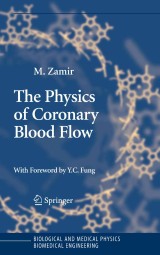Details

The Physics of Coronary Blood Flow
Biological and Medical Physics, Biomedical Engineering
|
106,99 € |
|
| Verlag: | Springer |
| Format: | |
| Veröffentl.: | 18.06.2006 |
| ISBN/EAN: | 9780387260198 |
| Sprache: | englisch |
| Anzahl Seiten: | 408 |
Dieses eBook enthält ein Wasserzeichen.
Beschreibungen
The fields of biological and medical physics and biomedical engineering are broad, multidisciplinary and dyanmic. They lie at the crossroads of frontier - search in physics, biology, chemistry, and medicine. The Biological & Me- cal Physics/Biomedical Engineering Series is intended to be comprehensive, covering a broad range of topics important to the study of the physical, che- cal and biological sciences. Its goal is to provide scientists and engineers with textbooks, monographs, and reference works to address the growing need for information. Books in the series emphasize established and emergent areas of science - cluding molecular, membrane, and mathematical biophysics; photosynthetic - ergy harvesting and conversion; information processing; physical principles of genetics; sensory communications; automata networks, neural networks, and cellular automata. Equally important will be coverage of applied aspects of b- logical and medical physics and biomedical engineering such as molecular el- tronic components and devices, biosensors, medicine, imaging, physical prin- ples of renewable energy production, advanced prostheses, and environmental control and engineering. Elias Greenbaum Oak Ridge, TN M. Zamir Department of Applied Mathematics University of Western Ontario London, Ontario, N6A 5B7 CANADA zamir@uwo.ca Library of Congress Cataloging-in-Publication Data Zamir, M. (Mair) The physics of coronary blood flow / M. Zamir. p. cm. — (Biological and medical physics, biomedical engineering) Includes bibliographical references and index. 1. Coronary circulation. 2. Hemodynamics. 3. Blood flow. I. Title. II. Series. QP108.Z36 2005 612.1?7—dc22 2005042502 ISBN-10: 0-387-25297-5 e-ISBN: 0-387-26019-6 Printed on acid-free paper.
Static Design Issues.- Modelling Preliminaries.- Basic Lumped Elements.- Forced Dynamics of the RLC System.- The Analysis of Composite Waveforms.- Composite Pressure-Flow Relations.- Lumped Models.- Elements of Unlumped-Model Analysis.- Basic Unlumped Models.- Dynamic Pathologies.
<P>The author, originally trained in fluid dynamics, has been teaching and working on the dynamics of blood flow in general and coronary blood flow in particular for the past thirty years and has produced a book that will appeal to physicians, physicists and engineers.</P>
<P>Coronary blood flow is blood flow to the heart for its own metabolic needs. In the most common form of heart disease there is a disruption in this flow because of obstructive disease in the vessels that carry the flow. The subject of coronary blood flow is therefore associated mostly with the pathophysiology of this disease, rarely with dynamics or physics. Yet, the system responsible for coronary blood flow, namely the "coronary circulation," is a highly sophisticated <EM>dynamical</EM> system in which the dynamics and physics of the flow are as important as the integrity of the conducting vessels. While an obstruction in the conducting vessels is a fairly obvious and clearly visible cause of disruption in coronary blood flow, any discord in the complex dynamics of the system can cause an equally grave, though less conspicuous, disruption in the flow.</P>
<P></P>
<P>This book is devoted specifically to the <EM>dynamics and physics</EM> of coronary blood flow. While relevance to the clinical and pathophysiological issues is clearly maintained, the book approaches the subject from a biomedical engineering point of view. With this perspective, <EM><STRONG>the Physics of Coronary Blood Flow</STRONG></EM> complements other treatments of the subject that focus largely on the clinical and pathophysiological issues.
<P></P>The author, originally trained in fluid dynamics, has been teaching and working on the dynamics of blood flow in general and coronary blood flow in particular for the past thirty years and has produced a book that will appeal to physicians, physicists and engineers.
<P></P>
<P></P>
<P>This book is devoted specifically to the <EM>dynamics and physics</EM> of coronary blood flow. While relevance to the clinical and pathophysiological issues is clearly maintained, the book approaches the subject from a biomedical engineering point of view. With this perspective, <EM><STRONG>the Physics of Coronary Blood Flow</STRONG></EM> complements other treatments of the subject that focus largely on the clinical and pathophysiological issues.
<P></P>The author, originally trained in fluid dynamics, has been teaching and working on the dynamics of blood flow in general and coronary blood flow in particular for the past thirty years and has produced a book that will appeal to physicians, physicists and engineers.
<P></P>
Dynamics, of fluid or solid objects, is a branch of physics, engineering, and applied mathematics and, as yet, it is not a branch of medicine Coronary heart disease, on the other hand, is a branch of medicine that, as yet, does not include the dynamics of coronary blood flow This book is dedicated to bridging these two seemingly disparate ends No other book found approaches either topics in this way Includes supplementary material: sn.pub/extras
<P>Dynamics, of fluid or solid objects, is a branch of physics, engineering, and applied mathematics and, as yet, it is not a branch of medicine. Coronary heart disease, on the other hand, is a branch of medicine that, as yet, does not include the dynamics of coronary blood flow. This book is dedicated to bridging these two seemingly disparate ends. The rise of biomedical engineering and biophysics in recent years attests to the need for this genre of books. The challenge is to produce a book that speaks successfully on both sides of the fence.</P>
Diese Produkte könnten Sie auch interessieren:

Alzheimer's Disease: Cellular and Molecular Aspects of Amyloid beta

von: J. Robin Harris, Falk Fahrenholz

213,99 €















